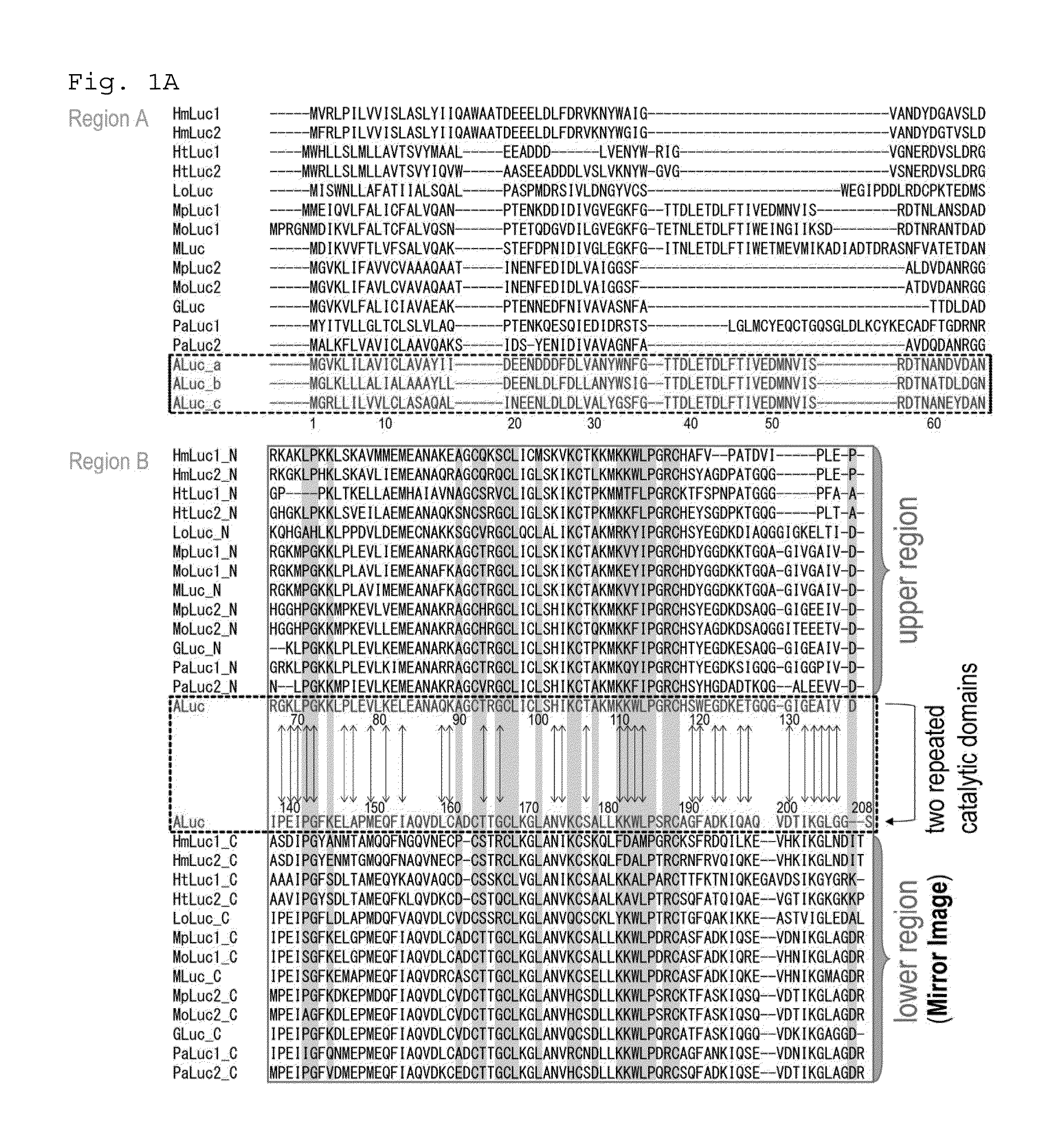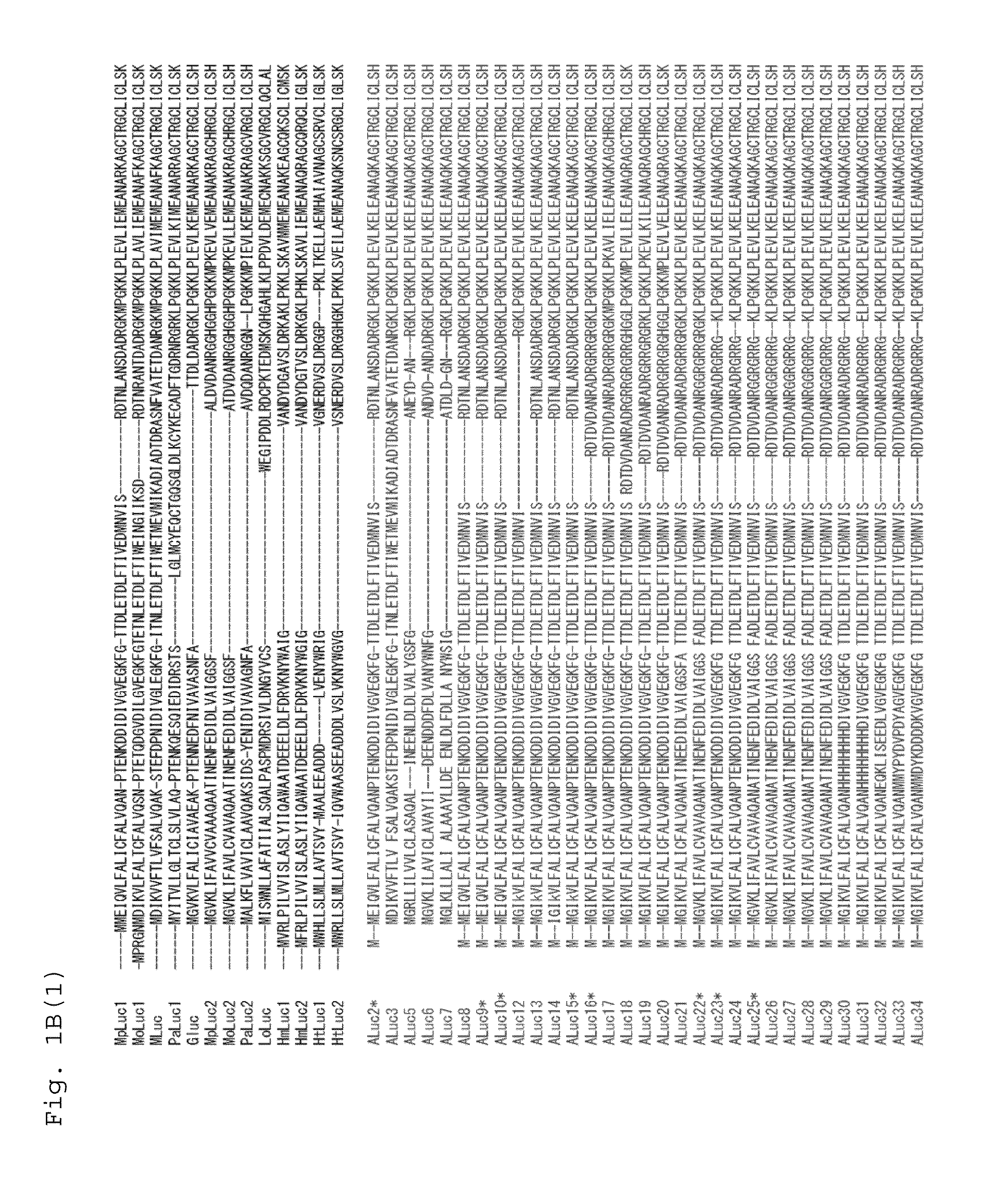Artificial bioluminescent enzyme
- Summary
- Abstract
- Description
- Claims
- Application Information
AI Technical Summary
Benefits of technology
Problems solved by technology
Method used
Image
Examples
example 1-1
Extraction of Amino Acid Sequences of Artificial Luciferases (ALucs)
[0301]According to the publicly known database of the National Center for Biotechnology Information (NCBI), etc., copepod luciferase sequences were aligned based on the similarity of amino acids to find frequently occurring amino acids. Based on the frequently occurring amino acids, novel artificial luciferase (ALuc) prototypes were made (FIG. 1A). Each of the luciferase sequences in the database was fragmented into the top portion, the first portion, and the second portion, and frequently occurring amino acid sequences were extracted from the similarity alignment of top portion sequences (FIG. 1B). Further, by overlapping the first portion and the second portion, not only frequently occurring amino acids but also amino acid sequences having high homology between the first portion and the second portion were extracted, thus making about 23 artificial luciferase sequences.
[0302]Based on the many artificial luciferase...
example 1-2
Comparison of Luminescence Intensity, Luminescence Stability, and Red-Shifted Degree of Artificial Luciferases (ALucs)
[0303]The artificial luciferase (ALuc) genes synthesized by the above process were subcloned into mammalian cell expression vectors (pcDNA3.1 (+)). Each expression vector was transfected with African green monkey kidney-derived COS-7 cells, and the luminescence intensity, luminescence stability, and red-shifted degree of artificial luciferases (ALucs) were compared (FIGS. 2 to 5).
[0304]First, the luminescence intensity of artificial luciferases (ALucs) was compared (FIG. 2). For the comparison, COS-7 cells containing a vector encoding each luciferase were cultured overnight, and then the relative luminescence intensity was measured by using an assay solution, which is a mixture of a cell lysis solution and a substrate, produced by Promega, and a luminescence image analyzer (LAS-4000).
[0305]The results indicated that ALuc2, ALuc9, ALuc10, ALuc15, ALuc16, ALuc18, ALuc2...
example 1-3
Examination of Luminescence Stability of Artificial Luciferases (ALucs)
[0306]The luminescence stability of the artificial luciferases (ALucs) of the present invention was examined in various respects (FIG. 3). COS-7 cells containing each luciferase gene were cultured for 9 hours, and treated with a cell lysis solution produced by Promega for 20 minutes. Temporal changes in luciferase luminescence intensity after the introduction of a substrate-containing reaction solution produced by Promega were observed every five minutes (FIG. 3A). As a result, after the substrate injection, a sudden luminescence decrease phenomenon was observed in conventional GLuc or ALuc2; however, ALuc15 and ALuc16 retained about 60% of their initial luminescence intensity even 25 minutes after the substrate injection.
[0307]This experiment was expanded to artificial luciferases ALuc16 to ALuc25 (FIG. 3BC). The results indicated that ALuc16, ALuc22, ALuc23, ALuc25, etc., had advantageous initial luminescence ...
PUM
| Property | Measurement | Unit |
|---|---|---|
| Fraction | aaaaa | aaaaa |
| Stability | aaaaa | aaaaa |
| Luminescence | aaaaa | aaaaa |
Abstract
Description
Claims
Application Information
 Login to View More
Login to View More - R&D
- Intellectual Property
- Life Sciences
- Materials
- Tech Scout
- Unparalleled Data Quality
- Higher Quality Content
- 60% Fewer Hallucinations
Browse by: Latest US Patents, China's latest patents, Technical Efficacy Thesaurus, Application Domain, Technology Topic, Popular Technical Reports.
© 2025 PatSnap. All rights reserved.Legal|Privacy policy|Modern Slavery Act Transparency Statement|Sitemap|About US| Contact US: help@patsnap.com



